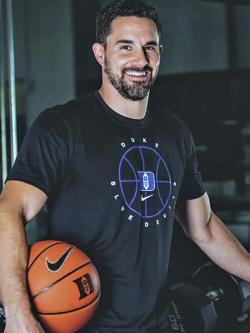Stay Fit with These Workouts at Your Fingertips
Duke Sports Performance staff members share body weight exercises that can help you stay strong and fit


According to the U.S. Centers for Disease Control and Prevention (CDC), one in four adults is inactive and does not get physical activity outside of work. And for people who have established a routine, even the most well-intentioned motivation can drop off when temperatures dip during winter.
Quick, high-intensity workouts with major muscle groups increase energy levels, speed up metabolism, improve mood, and lower risk factors for disease. When paired with proper diet, hydration and sleep, a steady exercise routine with them can help us all to perform our best in life and work.
“Ultimately, what we're trying to do every day when we show up to work is to be the best versions of ourselves,” Perlmutter said. “The fitter that we are physically, that gives us the freedom to be the best version of ourselves.”
Here are some exercises and insights from some of Duke’s sports performance coaches.
Plank Technique

The body’s core muscles, located around the abdomen, have an important role to play in protecting the spine.
But often, they can be weak, negatively affecting the rest of the body.
When pole vaulters, women’s lacrosse players and track and field throwers visit Nicole Shattuck, senior sports performance coach with Duke Athletics, she starts them on planks, which help them build more rotational power and core strength that benefits all muscles.
Planking is important for building strong core muscles that aid in activity, from picking up groceries to sitting up straight in a chair, Shattuck said.
When it comes to daily functions, planks build muscle groups that improve posture, decrease non-specific lower back pain and prevent falls.
“If you address your core strength, you’ll be better off in all those other areas,” Shattuck said. “If I start to correct some of those basic building blocks, it’s a domino effect. The other pieces will fall into place.
Squats

To Rodney Hill, assistant director of Sports Performance for Duke Football, no day in the weight room is more exhilarating than squat day.
When max squat day came for the football team last summer — when strength and progress is tested by lifting your one-rep maximum weight — players dressed up like World Wrestling Entertainment (WWE) pro wrestlers to show off their strength.
“For us, it’s all about making sure that they can stay strong and powerful, and that they’re able to run fast, jump high and push the person in front of them backwards, if need be,” Hill said. “That all starts with your legs.”
In normal life, body weight squats are an essential movement for building lower body strength. The exercise engages most muscles, tendons and joints in the legs, which are important for mobility, range of motion, posture and picking up heavy items without injuring yourself.
For more ease getting out of bed or getting up out of a chair, Hill recommends starting with a routine of three sets of 10 squats, squatting as far as you can while keeping your back upright before standing back up.
The benefits will be immediate for keeping your muscles active every day, which guards against muscle atrophy, a contributor to higher mortality rate.
“You’re not only training the muscles, but you’re training the movement pattern,” Hill said. “You’re training that range of motion, and that might be what’s most important about that. Along with that, you’ll frame basically your entire lower body. You’ll work on your quadriceps, your hamstrings, your calves, everything within your ankles and your feet and you’ll engage your core.”
Pushups

Pushups are often misunderstood as only a chest exercise, but when done correctly, the exercise strengthens other large muscle groups too, including stomach, glutes, quads and the tissue that links them.
“It can be pretty much a total body exercise, when done correctly,” said Justin Roach, the director of Sports Performance for the women’s basketball team.
Those muscle groups are crucial for athletes, who want upper body strength to rebound, score through contact and to defend the opposing team.
Pushups activate muscles around hips and building triceps and chest muscles that are needed for powerful movements and general strength. Whether performing pushups on your knees, variations with quicker reps or more sets, the benefits on a body remain the same.
“It’s going to help increase your overall strength,” Roach said. “Anytime you’re able to include your hips, you’re going to be able to transfer force better, and it’s a great way to connect the body, from chest to toes.”
Resistance Bands

Resistance band exercises are versatile workouts that can help anyone handle daily activity with more ease.
The bands — available at sporting goods stores — provide a variety of use, from stretching out your muscles to building strength in your upper body muscles. Jordan Bar, assistant director of Sports Performance, uses resistance bands during training with softball players and golfers to help them make solid contact with a ball.
When used for curls, rows, and other non-sport specific upper body exercises, the resistance of the band builds the muscle groups in your back, chest and arms that are needed to lift heavy items, reach over our heads, or open and close doors. Each person can set the level of resistance.
“If your body gets stronger, whether it’s using resistance bands or some other form of resistance, you’re going to be able to handle those things you do every day with a lot more ease,” Bar said. “If you can increase the ceiling a little bit of what your strength currently is, everything underneath that is going to be a little bit easier to deal with and it’s a little bit less stress on your body.”
Find a guide to resistance bands and workouts here.
Send story ideas, shout-outs and photographs through our story idea form or write working@duke.edu.